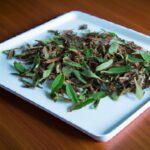Tempeh, with its rich history and potent nutritional profile, has become a darling of plant-based kitchens worldwide. Yet, for many home cooks, its naturally bold and slightly bitter taste can be a tough nut to crack. Fear not-banishing bitterness and unlocking tempeh’s full flavor potential is not only possible but also a culinary adventure worth embarking on. In this article, we’ll dive into expert tips and clever tricks that transform tempeh from a challenging ingredient into a savory star, ensuring every bite is a delightful celebration of texture and taste. Whether you’re a seasoned vegan or a curious cook, get ready to perfect your tempeh and savor its unique magic like never before.
Banish Bitterness: Expert Tips to Perfect Tempeh Flavor
Banish bitterness is the key phrase every tempeh lover needs to unlock the full potential of this ancient Indonesian superfood. Originally crafted as a protein-rich staple in Sundanese cuisine, tempeh carries a complex flavor profile often shadowed by a natural bitterness that can challenge new cooks. With the right understanding of its science-how fermentation shapes its taste-and by mastering soaking, marinating, and cooking techniques, you can transform tempeh into a versatile, delicious canvas bursting with nutty, earthy, and savory notes. This guide will equip you with practical steps to neutralize bitterness, coax out tempeh’s subtler flavors, and pair it with complementary ingredients for dishes that excite the palate.
Prep and Cook Time
- Prep Time: 30 minutes (including soaking and marinating)
- Cook Time: 15 minutes
Yield
Serves 4 as a main dish or 6 as a side
Difficulty Level
Medium
Ingredients
- 1 block (8 oz) tempeh, cut into ½-inch slices or cubes
- 2 cups warm water
- 1 tablespoon apple cider vinegar
- 3 tablespoons soy sauce (or tamari for gluten-free)
- 1 tablespoon maple syrup or coconut sugar
- 2 cloves garlic, finely minced
- 1 teaspoon grated fresh ginger
- 1 teaspoon toasted sesame oil
- ½ teaspoon smoked paprika
- Freshly ground black pepper, to taste
- 2 tablespoons neutral oil (such as avocado or canola) for cooking
Instructions
- Soak the Tempeh: Place tempeh slices in a shallow dish with warm water mixed with 1 tablespoon apple cider vinegar. Soak for 15-20 minutes to soften and mellow bitterness. This acidic soak begins breaking down bitter compounds gently.
- Prepare Marinade: In a bowl, whisk together soy sauce, maple syrup, minced garlic, grated ginger, sesame oil, smoked paprika, and freshly ground black pepper. The sweetness from the maple syrup balances bitterness while the umami-rich soy sauce deepens flavor complexity.
- Marinate the Tempeh: Drain tempeh and pat dry with paper towels. Place in the marinade, ensuring each piece is fully coated. Cover and refrigerate for at least 15 minutes, ideally 1 hour for more flavor penetration.
- Preheat Pan and Oil: Heat 2 tablespoons of neutral oil in a skillet over medium heat. Ensuring the pan is hot before adding tempeh allows for a golden crust that seals in moisture and adds a pleasant nuttiness.
- Sauté Tempeh: Add marinated tempeh slices without crowding the pan. Cook 4-5 minutes per side until golden brown and slightly crispy, turning carefully to prevent breaking. This caramelization heightens tempeh’s natural mellow nuttiness.
- Rest and Serve: Remove from heat and let tempeh rest for a couple of minutes to retain its juices and flavor. Transfer to serving dishes and garnish as desired.
Tips for Success
- Control Bitterness: Always soak tempeh first to minimize raw bitterness. Adding vinegar dramatically enhances this step.
- Marinade Flexibility: Feel free to swap soy sauce for liquid aminos or miso paste for deeper umami notes. Adjust sweetness with honey or agave to taste.
- Crisp Texture Tips: Avoid overcrowding the pan for even cooking and crisp edges. Use a cast-iron skillet if available for superior heat distribution.
- Make-Ahead: Marinated tempeh can be refrigerated overnight. Reheat gently in a skillet or air fryer for maximum crispness.
- Flavor Layering: Complement spices like cumin, coriander, or chili flakes can be added to the marinade for a more robust, complex profile.
Serving Suggestions
Serve your perfectly balanced tempeh over a bed of steamed jasmine rice or quinoa. Add vibrant sautéed greens like bok choy or kale for a well-rounded meal. A sprinkle of toasted sesame seeds or chopped fresh cilantro adds visual appeal and a burst of freshness. Drizzle with a cooling coconut-yogurt sauce or tangy tamarind dressing to contrast tempeh’s nutty depth. For a casual twist, tuck slices into warm pita pockets with crunchy slaw and pickled red onions for texture and brightness.

| Nutrient | Per Serving |
|---|---|
| Calories | 220 kcal |
| Protein | 18 g |
| Carbohydrates | 10 g |
| Fat | 12 g |
For more ways to elevate plant-based proteins, check out our Ultimate Guide to Plant-Based Proteins. Learn about health benefits of fermented foods here.
Q&A
Q&A: Banish Bitterness – Expert Tips to Perfect Tempeh Flavor
Q1: Why does tempeh sometimes taste bitter?
A1: Tempeh’s natural fermentation process can sometimes yield a mild bitterness, especially if it’s undercooked, over-fermented, or made from certain soybeans or grains. Additionally, the presence of compounds like isoflavones and tannins in soy can contribute to that bitter edge.
Q2: How can I reduce tempeh’s bitterness before cooking?
A2: Start with a good soak! Marinating tempeh in acidic ingredients like lemon juice, apple cider vinegar, or tamari for 20-30 minutes helps neutralize bitterness. Another trick is to steam or simmer tempeh briefly before frying-it softens the texture and mellows harsh flavors.
Q3: Are there any seasoning hacks to mask bitterness?
A3: Absolutely! Flavor layering is your ally. Incorporate umami-rich ingredients like miso, soy sauce, or nutritional yeast to balance bitterness. Spices such as smoked paprika, garlic, and ginger add depth and complexity that distract the palate from bitter notes.
Q4: What cooking methods enhance tempeh’s flavor while reducing bitterness?
A4: Grilling or pan-frying tempeh after marinating creates a caramelized crust that offsets bitterness with a smoky, nutty taste. Baking it with a glaze of maple syrup, barbecue sauce, or balsamic reduction also brings out natural sweetness and richness.
Q5: Can choosing the right tempeh variety make a difference?
A5: Yes! Tempeh comes in various forms-soybean, chickpea, black bean, or mixed grains. Experimenting with different types can lead to less bitter options. Additionally, fresh tempeh is less bitter than overly fermented or aged batches.
Q6: How important is freshness in preventing bitterness?
A6: Very important! Fresh tempeh stored properly in the fridge or freezer retains mild, pleasant flavors. Older tempeh can develop stronger, unwanted bitterness and an off-putting aroma.
Q7: Any final pro-tips to perfect tempeh’s flavor?
A7: Treat your tempeh like a blank canvas-marinate boldly, cook creatively, and pair it with complementary flavors. Don’t shy away from sweet, sour, salty, and spicy elements. With a little experimentation, bitterness will be a distant memory and tempeh will become a star of your plate.
Closing Remarks
In the quest to transform tempeh from a humble soy product into a culinary delight, conquering bitterness is the key that unlocks its full potential. With these expert tips, you’re now equipped to elevate tempeh from bitter to brilliant-infusing every bite with rich, satisfying flavor that delights the palate. Whether marinated, steamed, or pan-fried, tempeh’s versatility awaits your creative touch. So go ahead, banish bitterness, and let tempeh shine as the star ingredient in your kitchen adventures. Your taste buds will thank you.








